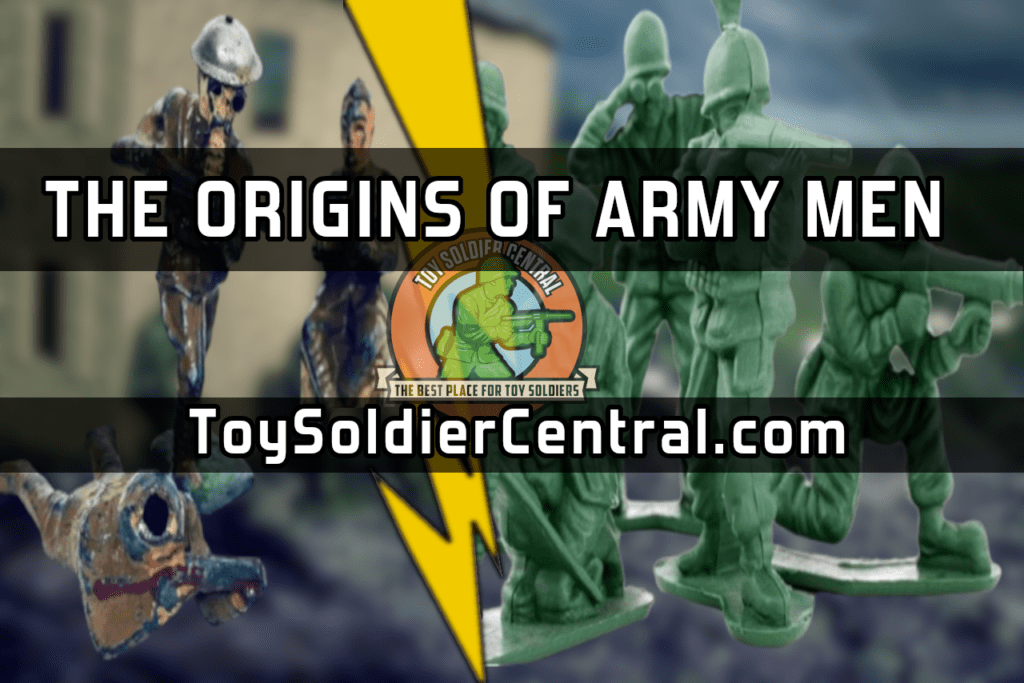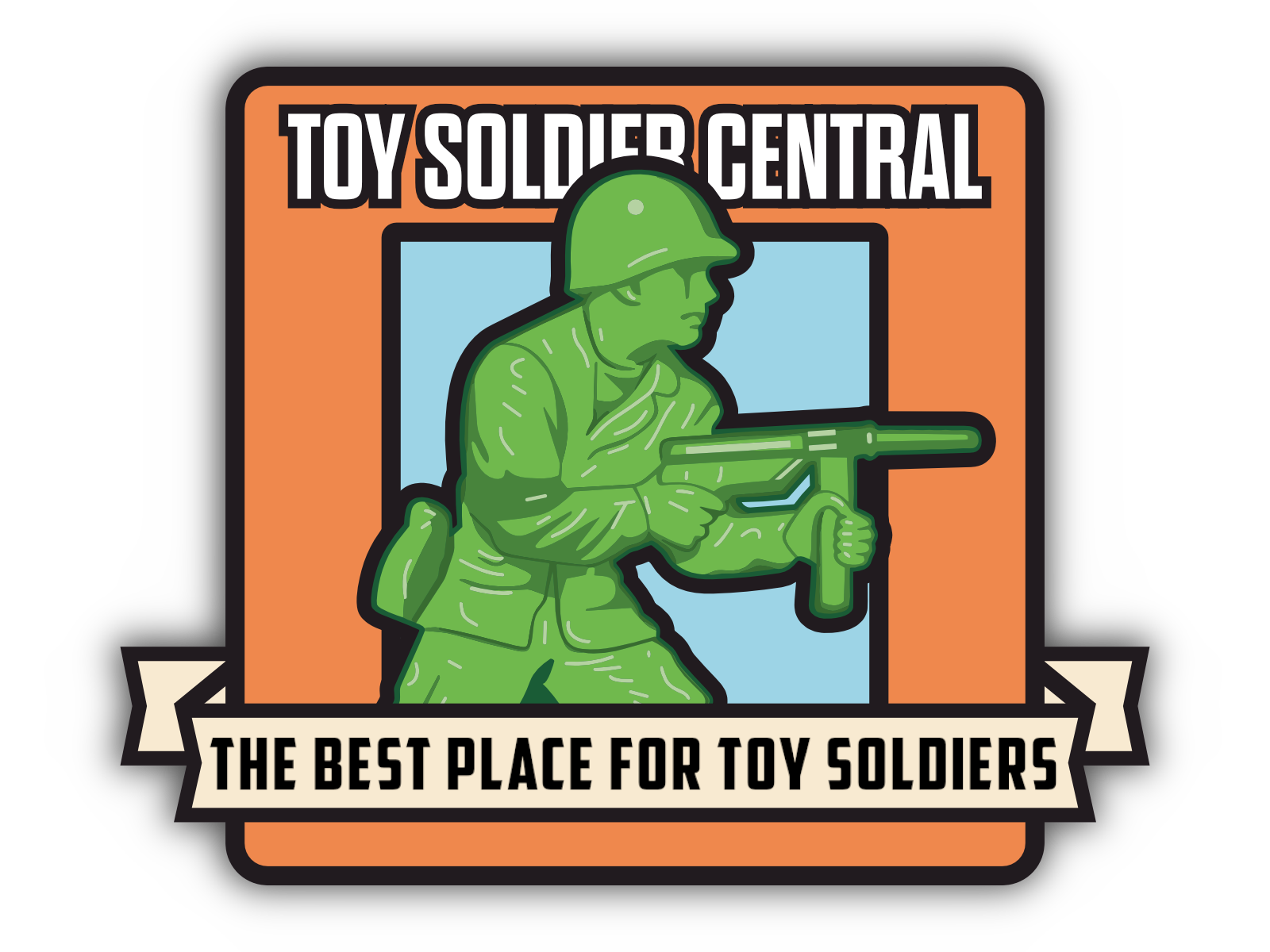
Have you ever wondered “where did army men come from?”
A lot of people have! We all know about green plastic army men. Most of us play with the little green toy soldiers too. But, their history is rarely explored.
That’s a shame, because the origin story of plastic army men is full of intriguing struggles, triumphs, and trivia!
In this post, you’ll learn all about the history of army men. You’ll also find out how their origins are intertwined with the creation of toy soldiers from the past.
How Toy Soldiers Gave Birth To Army Men
Before plastic army men of the modern age, there were tin toy soldiers.
Various cheap metals and alloys made tin toy soldiers. Some examples include tin, lead, zinc, or antimony.
But toy soldiers have fascinated collectors since ancient times. They trace back to the era of the Pharaohs in ancient Egypt.
Those first toy soldiers were crafted from materials like wood, stone, clay, and metal. They were reserved for the affluent.
However, it was only in the late 18th century that the first “real” toy figures, known as military miniatures, saw the advent of mass production.
Petite lead figures standing at approximately 2 inches tall were crafted in limited quantities by the Parisian company “Mignot”. They were adorned in colorful uniforms and possessed an undeniable charm.
However, their allure was tempered by their high cost, preventing widespread popularity.
Despite this, other manufacturers, including the German firm “Heyde,” entered the scene, leading to the establishment of a market catering to the well-to-do by the conclusion of the 19th century.
Tin toy soldiers surged to popularity in the late 19th century! Germany became the leading producer of tin toy soldiers, followed by England and France. Tin toy soldiers came in 3 distinct styles.
There were solid soldiers – or “3D” figures. Next were the flats, which were paper-thin, almost 2D looking figures. Finally, the semi-soldiers, which were something between the former categories.
Later, companies made their solid soldiers hollow. This resulted in a lighter weight figure. It also decreased the cost and increased its accessibility.
Toy makers always focused on current and historical armies.
This is true even from the beginning, with the earliest toy soldiers. 18th century toy soldiers featured armies from ancient Egypt to Victorian era armies.
(Funny enough, what they considered “current” back then is now considered “historical!”)
The artists often painted these tin toy soldiers in bright, glossy colors. Then, they got sold in boxes, with about 6 to 8 footmen to a box set. Sometimes, accessories got included in these box sets.
You could expect to find wagons, cannons, engineering equipment with your toy soldiers.
You could also discover bridges, fortifications, and buildings in your set! Some even crafted from the shiny embrace of tin, or the whimsy of wood composition and paper mâché.
Shortly before the dawn of the 20th century, the English firm “William Britains” revolutionized the landscape by introducing a more affordable line of hollow cast leads.
These figures, maintaining a height of about 2 ¼ inches (still adhering to industry standards), finally gained traction among children.
Depicting armies of England, America, France, Germany, and their adversaries, these “little men” became a cultural phenomenon.
Noteworthy people like Winston Churchill and H.G. Wells were avid toy soldier collectors.
They were captured in old photographs playing with armies of Britains toy soldiers on their rugs and lawns.
What Scales & Sizes Do Toy Soldiers Come In?
For the scales of toy soldiers, things get kinda confusing.
They come in all kinds of different scales, shapes, and sizes. Don’t worry though, because we’ll break it down simple for you.
The height and size of toy soldiers are measured in two ways.
First is their millimeter scale height.
54mm, for example, is the standard height of army men.
You measure a figure the same way you’d measure a person – from their feet to the top of their head. It means the figure stands at 54 millimeters tall!
Next is the size scale ratio.
The standard scale ratio for army men is 1:32 (or 1/32).
This means that the figure is 1/32, the size of its real-life counterpart. That means you would have to multiply the size of a 1:32 scale army man by 32 times to match the size of a real soldier!
From the beginning until now, toy soldiers stand at 2 to 3 inches tall, on average. Toy soldier companies established the average height of a trooper since the beginning.
An English company called “Britain’s Limited” helped standardize the size of the common toy soldier. They are the primary contributor to the standardized toy soldier scale system.
Thanks to them, the standard size for an army man tends to be around 2 to 3 inches, or roughly 54 millimeters.
Smaller miniatures appeared among producers, too. These miniature figures stood at roughly 28-32 millimeters, and got deployed for war-gaming.
Afterward, 28-32mm (1:64 scale) became the standard for tabletop war-gaming toy soldiers. One example is Warhammer 40k by Games Workshop.
Although Warhammer 40k doesn’t have an official scale, they are accepted as coming in 28mm, 30mm, and 32mm. We’re now seeing an increase in the standard size of war-gaming miniatures.
The new standard size for wargaming miniatures is becoming 40mm sized figures, or 1:48 scale toy soldiers. What’s the main scale you use for toy soldiers? Tell us in comments below!
The History Of Toy Soldiers
People have been producing toy soldiers since ancient times, as stated above.
But the United States only began producing toy soldier figures since the start of World War 1! They had a lot of catching up to do. American toy soldier companies focused on scales ranging from 45mm to 90mm.
Among the produced troops were civil war era soldiers, plus cowboys and Indians.
Random vehicles of inaccurate scale are also common. Soon enough, spacemen, aliens, gangsters, and foreign soldiers got added to the mix. These miniatures range from solids to semi-solids.
One of the most popular toy soldiers ever produced was a figure from New Jersey.
They’re known as “pod foot” soldiers. Their feet had a special design – a hollow round shape, which allowed the toy soldiers to stand! These soldiers were World War 2 era figures.
They came with a plethora of marching and fighting troopers.
Why Are Toy Soldiers Made Of Plastic?
In the 1940s to the 1950s, concerns about lead poisoning grew among the public. Toy soldier manufacturing methods changed because of these growing concerns.
These were welcome changes because of the newfound availability of plastic. The wondrous invention known as plastic gained popularity during the middle of WW2!
After the war, there was a surplus of plastic, both hard and soft. This plastic surplus enabled toy soldier companies to make safer toys at lower costs. Thus, “army men” were born!
You might be wondering, what’s the difference between “army men” and “toy soldiers?”
It’s important to remember, army men are a certain kind of toy soldier. They are made of plastic, and designed to be cheap toys.
Remember this analogy: every husky is a dog, but not all dogs are huskies. Every army man is a toy soldier, but not all toy soldiers are army men.
Some toy soldier companies reproduced their old lead figures in plastic.
Those cheap plastic figures started getting sold by the bundle in plastic bags! Timmee Toys, a producer of popular US infantry army men, uses the same cast molds as old lead figures.
Other toy soldier companies designed and produced original figures.
Plastic was, and still is, a major upgrade from tin and other earth metals once used to produce toy soldiers. First, it’s way cheaper. Next, it allows for more intricate details on toy soldiers.
Thus, newer toy soldiers became more detailed and realistic as the generations went on.
In the USA, during the 1940s and 1950s, manufacturers produced the first plastic army men. They were replicas of lead figures, or new miniatures reflecting the contemporary military.
What Do Army Men Look Like? (Then & Now)
US troops got molded in various shades of green. They sported M1 rifles, .45 caliber pistols, and Thompson submachine guns, for starters. Some soldiers sported BARs, M3 grease guns, bazookas, grenades, and flamethrowers.
These are still the second most common plastic army men in the modern day. They’re fit for duty in the battlefields of WW2 era Europe, Korea, and the Pacific.
The absolute number one most common plastic army men of today are Vietnam era soldiers. They have barebones kits, consisting only of their M16 rifle. They sometimes replace their M16 with a bazooka, flamethrower, or radio.
These figures are being produced by TimMee Toys. They also are the inspiration for the army men we see in the Pixar movie, Toy Story. If you walk into the grocery store and head for the toy aisle, you’ll likely find a bag of these guys for sale.
For instance, there are TimMee recasts and Ideal’s ring-hand soldiers. There’s also a soldier with flat feet and no stands, made by Marx. Knock off toy soldiers like these would stand between 40mm and 54mm.
These army men were once available in every single store in America. Gas station, grocery store, convenience store, it didn’t matter – you’d be able to find a bag of army men with ease.
Nowadays, army men are usually only sold in toy soldier stores, or general toy stores. You may also run into them in the toy aisle of a grocery store, if you’re lucky.
But no matter where you bought your army men from, you’d always get troops, flags, and vehicles in your plastic play bag. The plastic play bag often contained jeeps, trucks, half-tracks, cannons, and tanks.
Who Produces Toy Soldiers?
Various companies have been producing toy soldiers and army men, from their origins until now. Currently, the majority of army men get produced in Taiwan or Hong Kong.
The most popular army men to date are off-brand knock offs. For every 1 original army man, there are 1000 knock-off clones made. This has been true since the 1950s!
In the early days of modern toy soldier production, a few dedicated companies emerged.
Some of the largest toy manufacturers produced their own “name brand” line of toy soldiers.
Louis Marx Inc. was the leading emerging brand. They were a large toy manufacturer that also explored electric trains. Marx sold their toy soldiers in small bags or large play sets.
The larger sets included army men, equipment, structures, defensive fortifications, and vehicles.
The following list shows the most popular Marx sets:
- WW2 Battlegrounds – My personal favorite, which featured the USA versus Germany during WW2.
- Civil War Battle – A play set featuring blue union troopers facing off against grey confederate troopers.
- Fort Apache Play set – A wild west themed army men play set.
- The Alamo – A specific army men play set that featured the Alamo. Army men play sets which feature Alamo soldiers are quite rare.
- Knights & Vikings – A historically inaccurate play set featuring ancient army men.
All those play sets included lithographed stamped metal structures.
The manufacturer assembled and fitted these structures with plastic parts. One structure was a castle. It had plastic tower battlements, a gate, and a drawbridge. Fort Apache was a plastic fort with a metal barracks. The Alamo consisted almost entirely of stamped metals.
Another toy company, named Ideal Toys, produced their own line of army men play sets. Multiple Products Corporation (MPC) also produced army men.
Their soldiers offered rare ring-hand troops. MPC was unique because they sold their toy soldiers separate from their weapons. This meant you could arm any soldier with whatever weapon you wished.
Both Ideal Toys and MPC also offered a variety of toy soldiers to choose from. Their options for eras included Civil War, WW2, Modern Times, Wild West, and space.
Marx had more refined play sets compared to Ideal & MPC. Still, they provided kids with everything they needed for playing war.
The Evolution Of Army Men (The Rise, Fall, & Renaissance Timeline)
Starting in the 1960s, a new form of Army Man found itself among the ranks of toy soldiers.
This was the generic “modern” US soldier, armed and equipped with the latest gear for that time era. That included the M-16 Assault rifle. Like all other army men, manufacturers sold these new army men in bag sets, including a tank, jeep, or sandbags.
The mid-1960s saw the complete integration of this new type of Toy Soldier.
This modern army man with an M-16 Rifle represented American Vietnam troops.
Manufacturers continue to produce them to this very day. These modern army men eclipse many of the older types of toy soldiers.
Some toy soldier manufacturers were fading out of the industry around this time. Marx, Giant, and others ceased their production.
Army Men fell in popularity in the late ‘60s for several reasons. The most prominent were cultural anti-war sentiments, and the invention of Action Figures.
Around the time of the fall of army men, hobby manufacturers had a secret plan. They worked behind the scenes with diligence to execute their plan. Soon, they produced their own versions of Army Men.
These were soft plastic soldiers, marketed to hobbyists as cheap scale figures. They were (and still are) sold in hobby stores, for hobby shop prices. These new figures saw marketing as “premium toy soldiers.”
This alone distinguished them from genuine army men, the common toy soldiers of our times.
In the early 1970s, British toy companies started selling their own toy soldiers.
The toy companies marketed their troops as affordable miniature toy soldiers, also known as scale models, instead of army men.
Thus, the influx of Airfix, Matchbox, and Timpo toy soldier figures arrived in the USA. These toy soldiers were more popular among serious hobbyists and toy soldier enthusiasts.
Those boxed figure sets were not available in traditional toy stores. Thus, their exclusivity and premium nature led to their soaring popularity.
The late 1970s saw another sharp decline in war toys, much to the dismay of toy soldier collectors. Several toy soldier manufacturers, like Marx, Ideal, and many more, went bankrupt.
Their departure from business left a void in the toy soldier market. While China continued to import knockoff bag-o-soldiers, their variety shrank. Many figures and poses vanished altogether.
In the late 1980s, hobby companies producing premium toy soldiers reduced production.
Some even ceased their production all together. Small knockoff companies copied their better figures and sold them in plastic bags.
That new generation of knock off toy soldiers are the most common kind of plastic army man today. They are smaller and less defined than the original figures.
But they are cheap and available in enormous quantities.
Conclusion – The Resurgence Of Army Men
Army Men and toy soldiers have seen a resurgence in recent years.
A fresh addition to the ranks of affordable army men are the cheap knockoffs of the premium British companies. Many new knockoff soldiers are clones of the original Airfix and Matchbox soldiers.
They are still sold in bags, plastic buckets, tubs, or even boxed play sets.
Sometimes, old American figures find their way back onto store shelves. Specialty companies own both the original molds and recasts of the classic Marx figures.
BMC Toys proudly sells recasts of the original Marx army men.
Thanks to companies like Victory Buy, we’ve seen the revival of American army men manufacturers.
For example, Processed Plastics, TimMee, BMC, and Marx toy soldiers have all returned to life because of Victory Buy.
Several new toy soldier companies have also risen to prominence in recent years. That includes Toy Soldier Central!
Some of these toy soldier companies also produce army men, which we all know and love.
Army Men have also been prominently featured in popular culture of recent years.
The 1991 release of Toy Story saw Woody command little green army men.
The 3DO Company produced several dozen video game titles featuring army men. Their war games featured army men of various colors, with the tag line of “Real Combat, Plastic Men.”
It’s safe to say, Army Men are making a comeback. We are entering the pinnacle of the modern Toy Soldier Renaissance. So grab a bag of little green plastic army men, and start playing war!

